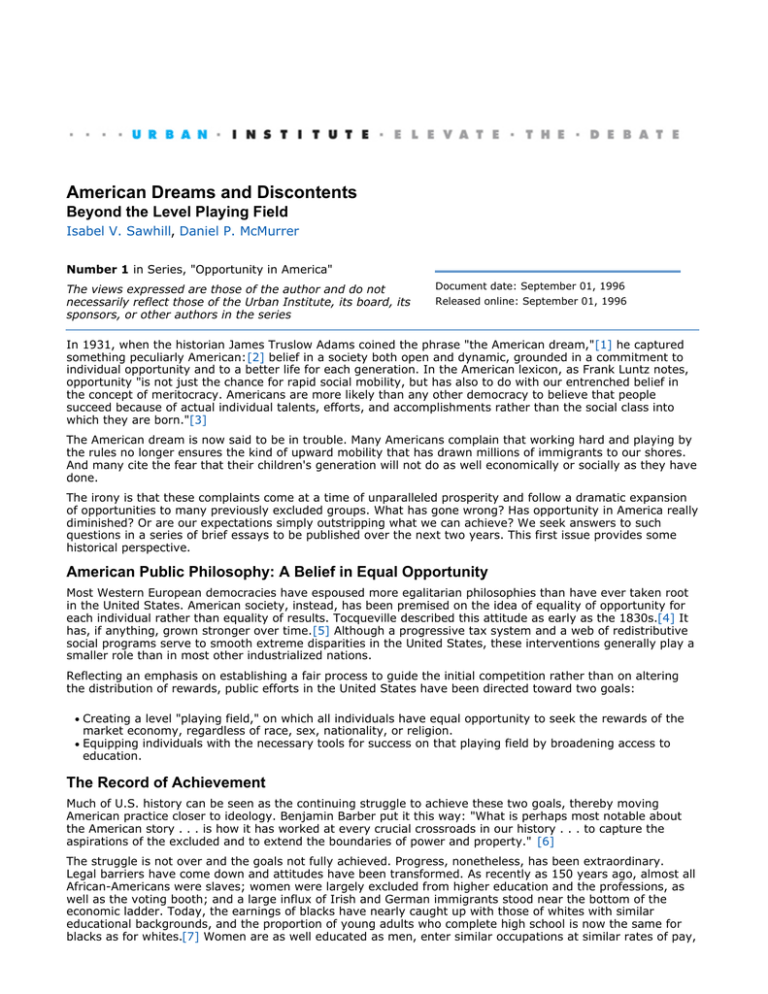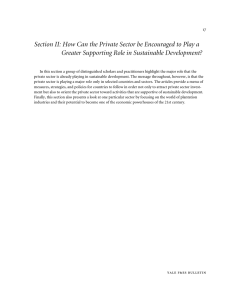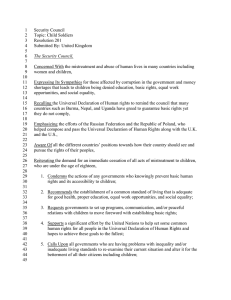American Dreams and Discontents Beyond the Level Playing Field Isabel V. Sawhill
advertisement

American Dreams and Discontents Beyond the Level Playing Field Isabel V. Sawhill, Daniel P. McMurrer Number 1 in Series, "Opportunity in America" The views expressed are those of the author and do not necessarily reflect those of the Urban Institute, its board, its sponsors, or other authors in the series Document date: September 01, 1996 Released online: September 01, 1996 In 1931, when the historian James Truslow Adams coined the phrase "the American dream,"[1] he captured something peculiarly American:[2] belief in a society both open and dynamic, grounded in a commitment to individual opportunity and to a better life for each generation. In the American lexicon, as Frank Luntz notes, opportunity "is not just the chance for rapid social mobility, but has also to do with our entrenched belief in the concept of meritocracy. Americans are more likely than any other democracy to believe that people succeed because of actual individual talents, efforts, and accomplishments rather than the social class into which they are born."[3] The American dream is now said to be in trouble. Many Americans complain that working hard and playing by the rules no longer ensures the kind of upward mobility that has drawn millions of immigrants to our shores. And many cite the fear that their children's generation will not do as well economically or socially as they have done. The irony is that these complaints come at a time of unparalleled prosperity and follow a dramatic expansion of opportunities to many previously excluded groups. What has gone wrong? Has opportunity in America really diminished? Or are our expectations simply outstripping what we can achieve? We seek answers to such questions in a series of brief essays to be published over the next two years. This first issue provides some historical perspective. American Public Philosophy: A Belief in Equal Opportunity Most Western European democracies have espoused more egalitarian philosophies than have ever taken root in the United States. American society, instead, has been premised on the idea of equality of opportunity for each individual rather than equality of results. Tocqueville described this attitude as early as the 1830s.[4] It has, if anything, grown stronger over time.[5] Although a progressive tax system and a web of redistributive social programs serve to smooth extreme disparities in the United States, these interventions generally play a smaller role than in most other industrialized nations. Reflecting an emphasis on establishing a fair process to guide the initial competition rather than on altering the distribution of rewards, public efforts in the United States have been directed toward two goals: Creating a level "playing field," on which all individuals have equal opportunity to seek the rewards of the market economy, regardless of race, sex, nationality, or religion. Equipping individuals with the necessary tools for success on that playing field by broadening access to education. The Record of Achievement Much of U.S. history can be seen as the continuing struggle to achieve these two goals, thereby moving American practice closer to ideology. Benjamin Barber put it this way: "What is perhaps most notable about the American story . . . is how it has worked at every crucial crossroads in our history . . . to capture the aspirations of the excluded and to extend the boundaries of power and property." [6] The struggle is not over and the goals not fully achieved. Progress, nonetheless, has been extraordinary. Legal barriers have come down and attitudes have been transformed. As recently as 150 years ago, almost all African-Americans were slaves; women were largely excluded from higher education and the professions, as well as the voting booth; and a large influx of Irish and German immigrants stood near the bottom of the economic ladder. Today, the earnings of blacks have nearly caught up with those of whites with similar educational backgrounds, and the proportion of young adults who complete high school is now the same for blacks as for whites.[7] Women are as well educated as men, enter similar occupations at similar rates of pay, and can swing a national election to a candidate who lacks majority support among men. Numerous earlier generations of immigrants have achieved levels of success that often surpass those of native-born Americans. Efforts to extend rights to previously excluded groups have been accompanied by a continuing expansion of educational opportunities. The importance of the education system in creating opportunity has grown as other sources of opportunity have faded. During the 1800s, the vast expanse of unsettled territory was a primary means through which the nation delivered on its promise of a chance of advancement for all citizens, leading Frederick Jackson Turner to deem the West "another name for opportunity."[8] But even then, the common school was viewed as a great leveler and source of upward mobility.[9] With the closing of the frontier around the turn of the century, Americans increasingly looked to education as the primary source of opportunity. In 1940, Harvard president James Bryant Conant called the public schools a "vast engine" for "regaining that great gift to each succeeding generation—opportunity, a gift that was once the promise of the frontier."[10] The education system expanded dramatically. Between 1900 and 1975, secondary school enrollment increased from 10 percent to over 90 percent among children ages 14 to 17. During the same period, the high school graduation rate increased from 7 percent to 73 percent.[11] College enrollment and graduation rates have also increased significantly.[12] Today, with technology playing an ever more central role in all industries, the demand for highly educated workers has increased still further.[13] Reflecting this increase, the wage premium for education has grown. In 1972, college graduates, on average, earned 38 percent more than high school graduates. By 1993, this differential had increased to 57 percent.[14] The scale of public spending on education reflects the central role played by education in the United States. While the United States spends relatively little on direct redistributive efforts, it has historically spent more per capita on education than almost any other industrialized nation. In school year 1990-91, for example, the proportion of Gross Domestic Product spent on public education (at 4.9 percent) was higher than in any other G-7 nation except Canada.[15] Yet most Americans voice support for even more government spending on education. Americans also rank highest in the world in the percentage of citizens who receive higher education, and Americans still remain much more likely than individuals in other countries to support further expansion of higher education opportunities.[16] Discontents of a Meritocracy A society based on equality of opportunity rewards ability and achievement—the dictionary definition of a meritocracy. Historically, the ideal of equal opportunity in the United States has been so grossly compromised by differential treatment of particular groups that much of the nation's political energy has been absorbed by efforts to rectify these injustices. Few have speculated about what society might look like if true equality of opportunity were to be achieved. While that time has not been reached, we have moved far enough to discover that a society based on meritocratic principles is not an unmixed blessing. As the importance of discrimination and illiteracy has faded, other factors—some long overshadowed and others newly emergent—are now playing an increasing role in shaping individual opportunity. Persistence of Inequality Progress in eliminating discrimination has not gone hand in hand with reductions in inequality; it has only reshuffled winners and losers in the competition. Many may well have hoped that leveling the playing field would change the distribution of income—a hope that in retrospect was doomed to failure. Changing the rules governing the competition for wealth and status does nothing to change the structure of the market economy and the rewards that flow from it. The degree of inequality is unchanged, even though who ends up where in the income distribution changes. [17] Psychological Fallout As access to education or jobs becomes more open, those who do not succeed can no longer point so easily to some external source for their failure.[18] The closer society moves to a level playing field, the more likely it is that the consequences of individual failures will have to be confronted—by society as a whole as well as by the individuals themselves.[19] Effects on the Family The leveling of the playing field has liberated women from purely domestic roles. This dramatic change, along with the growth of the welfare state, has undermined the economic basis of marriage. As job opportunities for women have increased, their dependence on a husband's earnings and on the institution of marriage has declined. This has led to more divorce, and to more childbearing outside marriage—trends that have been at least partly responsible for the dramatic growth of single parent families. [20] In the three decades since 1950, the number of children living in single-parent families has increased from 7 percent to 27 percent. This increased incidence of single-parent families, in turn, has had major consequences for the distribution of income and future opportunities for children. A New Economic Environment Finally, two economic developments of the last two decades—slowed growth and structural changes that have placed a new premium on skill and education—are threatening the American dream. As long as America was blessed with rapid economic growth, no matter where one was on the economic ladder one could reasonably expect one's children to reach a higher rung. As the growth rate has slowed since the early 1970s, the competition increasingly resembles a game in which one individual can gain only to the extent that another loses. In this environment, where economic growth is not enough to provide all with a ready path up the economic ladder, the opportunity structure matters more, and issues of fairness become more salient. This conclusion is strengthened to the extent that the rate of growth that we experienced in our earlier history was a function of unique factors—such as unlimited access to land and other natural resources in the 19th century, and an inexhaustible world market for our goods in the wake of World War II. It would be nice to believe that we could improve economic opportunities by ratcheting up the growth rate to earlier levels, but no one has yet devised a credible strategy for doing so. Economic growth has not only slowed, but its benefits now accrue almost entirely to those with the most education. Simply being a loyal, hard-working employee no longer guarantees that one will achieve the American dream. Whatever progress has been made in extending educational opportunities, it has not kept pace with the demand. The fate of the unskilled and the least able in this new environment is a new worry not easily reconciled with existing ideology. Looking Forward America may not be a true meritocracy. Social class and race still matter. Still, the country has progressed far enough toward its historically-given goal of equal opportunity to make many wonder why we, as a society, are not feeling more optimistic about the future. The persistence of inequality, the loss of external rationales for failure, the decline of marriage and the family, and the new economic environment—all have contributed, in our view, to current discontents. The briefs that follow will discuss these and related challenges in more detail. Notes 1. See Robert Samuelson (The Good Life and Its Discontents, Times Books, 1995) for more on Adams and the American dream.[Return] 2. For a discussion of American "exceptionalism," see Seymour Martin Lipset, American Exceptionalism, W.W. Norton (1996).[Return] 3. Frank I. Luntz, "Americans Talk About the American Dream," in The New Promise of American Life, edited by Lamar Alexander and Chester E. Finn, Jr., Hudson Institute, Indianapolis (1995).[Return] 4. One should distinguish American ideology and American practice. Some scholars who have studied the actual degree of social mobility around the time of Tocqueville, using the best available data, find little evidence of a rags to riches pattern. See Three Centuries of Social Mobility in America, Edward Pessen, ed., D.C. Heath & Co. (1974).[Return] 5. Lipset (1996: 98).[Return] 6. Benjamin Barber, An Aristocracy of Everyone: The Politics of Education and the Future of America, Ballantine Books (1992: 71).[Return] 7. Jennifer Day, "Educational Attainment in the United States: March 1995," U.S. Census Bureau Report P20-489, 1996. [Return] 8. Frederick Jackson Turner, "The Problem of the West," The Atlantic Monthly (September 1896).[Return] 9. See, e.g., "The United States at Midcentury," in James M. McPherson, Battle Cry of Freedom: The Civil War Era, Oxford University Press (1988).[Return] 10. James Bryant Conant, "Education for a Classless Society: The Jeffersonian Tradition," Atlantic Monthly (May 1940).[Return] 11. U.S. Bureau of the Census, Historical Statistics of the United States, Colonial Times to 1970 (1970).[Return] 12. For example, the percentage of the population (age 25 and over) with at least a college degree almost tripled between 1960 and 1994 (from 7.7 percent to 22.2 percent). U.S. Bureau of the Census, Statistical Abstract of the United States 1995.[Return] 13. Lawrence F. Katz and Kevin M. Murphy, "Changes in Relative Wages, 1963-1987: Supply and Demand Factors," Quarterly Journal of Economics 107 (Feb. 1992: 35-78).[Return] 14. Lawrence Mishel and Jared Bernstein, The State of Working America 1994-95, M.E. Sharpe (1994).[Return] 15. National Center for Education Statistics, The Condition of Education 1994, U.S. Government Printing Office (1994: 150). The Group of Seven nations are Canada, France, Germany, Italy, Japan, the United Kingdom, and the United States.[Return] 16. Lipset (1996: 83).[Return] 17. Indeed, the erosion of traditional norms about who should hold what jobs at what pay (women should become nurses, not doctors, etc.) appears to have been accompanied by an erosion of social constraints on become nurses, not doctors, etc.) appears to have been accompanied by an erosion of social constraints on employer hiring and compensation practices more generally. At the extreme, more open and geographically widespread competition can contribute to the rise of what Robert Frank and Phillip Cook (The Winner-Take-All Society, Martin Kessler Books, 1995) call "winner-take-all" labor markets, which bid up the salaries earned by top performers in a particular field. Those individuals who were previously protected from competition by virtue of being male, white, or the best at whatever they do in their town, have been hurt most by these developments. Thus, by loosening the role of social norms and limited spheres of competition relative to the role of supply and demand, the move toward meritocracy may actually increase inequality. White males with little education have been particularly affected. [Return] 18. Amartya Sen (Inequality Reexamined, Russell Sage Foundation, 1992: 6) notes that the opposite may also occur, "in situations of persistent adversity and deprivation, the victims do not go on grieving and grumbling all the time, and may even lack the motivation to desire a radical change of circumstances."[Return] 19. Many commentators have discussed this problem. See, e.g., Daniel Bell, "On Meritocracy and Equality," The Public Interest (1970: 43) and Mickey Kaus, The End of Equality, Basic Books (1992: 47).[Return] 20. See, e.g., Andrew J. Cherlin, Marriage, Divorce, Remarriage, Harvard University Press (1992: 51-52). [Return] About the Authors Isabel V. Sawhill is a Senior Fellow and holds the Arjay Miller chair in public policy at the Urban Institute. Daniel P. McMurrer is a Research Associate at the Urban Institute. Other Publications by the Authors Isabel V. Sawhill Daniel P. McMurrer Usage and reprints: Most publications may be downloaded free of charge from the web site and may be used and copies made for research, academic, policy or other non-commercial purposes. Proper attribution is required. Posting UI research papers on other websites is permitted subject to prior approval from the Urban Institute—contact publicaffairs@urban.org. If you are unable to access or print the PDF document please contact us or call the Publications Office at (202) 261-5687. Disclaimer: The nonpartisan Urban Institute publishes studies, reports, and books on timely topics worthy of public consideration. The views expressed are those of the authors and should not be attributed to the Urban Institute, its trustees, or its funders. Copyright of the written materials contained within the Urban Institute website is owned or controlled by the Urban Institute. Source: The Urban Institute, © 2012 | http://www.urban.org




